Designing assessment
The first step of the assessment cycle is deciding about your assessment design. You start by formulating your learning objectives, thinking about the purposes of the assessment, choosing a suitable method (or more than one), and bringing it all together in your assessment scheme. Then you can construct the assessment specification table, as the blueprint for a specific assessment method you will use.
A nice consideration might be whether you will and can involve students in this process.
With these sound preparatory actions, you will be well on your way.
- Prerequisite: Formulating learning objectives
The essence of learning outcomes and how to formulate them
Why are learning objectives so essential?
Clear and well-formulated learning outcomes guide all decisions you need to make regarding the teaching and learning activities and assessment in your course (see also: Constructive alignment).
NB. We use most of the time the term learning objectives but the term intended learning objectives or outcomes (ILOs) is also often heard or learning goals.
Advantages of formulating learning objectives:- it provides focus. It shows what is important, and what is the general level of learning.
- it is a way of sharing your ideas about the learning objectives within your programme. Peers, educational designers, and colleagues can give advice and feedback. You and others can see and discuss how a course fits into the curriculum plan and relates to other courses.
- it gives guidance on the design of your assessment.
- it gives guidance on the design of your teaching activities.
- it gives guidance on the materials you need for your students.
- it gives direction to the students' learning process.
How to write clear learning objectives?
It is important that you formulate clear learning objectives. But how can you realize this? Very briefly explained, the essence of formulating learning objectives is that...A good notion about how to write clear learning objectives provides the following video:
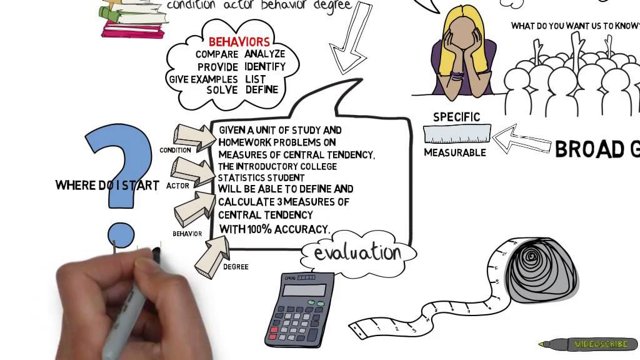
To summarize:
- You start with: At the end of the course the student is able to... Or make it a bit more personal: ... you will be able to....
- Outcomes should be observable and measurable. They demonstrate that students have learned knowledge,,achieved skills and competencies at a specific proficiency level.
- Use active verbs. Verbs like: write, draw, tell, analyze, calculate etc. Avoid verbs that are rather vague and ambiguous, like: think, understand.
- Be as specific and clear as possible.
Action verbs
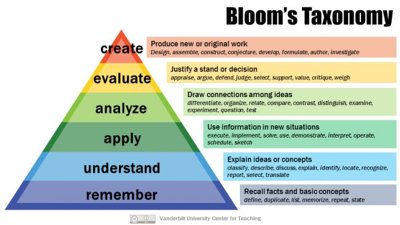 Benjamin Bloom (1956) designed a taxonomy for learning objectives in the cognitive (knowledge-based), affective (emotion-based) and psychomotor (action-based) domain.
Benjamin Bloom (1956) designed a taxonomy for learning objectives in the cognitive (knowledge-based), affective (emotion-based) and psychomotor (action-based) domain.
The cognitive domain taxonomy is mostly used in the education context. The Bloom structure helps to structure and align the learning objectives, assessments and teaching activities. The most import thing is that this model may help you to think about what you really want the students to be able to at the end of your course and to specify this as specific and clear as possible. See it as an aid.
On the right we show you the taxonomy in a picture. Actually, this is the revised version by Anderson & Krathwohl (2001). A lot of information and nice models can be found on Internet when you search for Bloom's taxonomy. See also some suggestions further below.For those who like to get more ideas:
Would you like to have some support in formulating the ilo's? This Learning Objective Maker (easygenerator.com) might help.
Hand-out Writing learning outcomes: A very helpful, practical article about formulating learning objectives. In this hand-out you can also find information about Benjamin Blooms' taxonomy. Bloom identified several levels, each with a list of suitable verbs, for describing levels in objectives. The levels are arranged from the least complex levels of thinking to the most complex levels of thinking. NB. We are not sure about the copyright. If you know more about it, we would like to give credits.
Alternatives for Bloom?
Bloom is very common, but there are other taxonomies. One of the more well-known ones is the Structure of the Observed Learning Outcome (SOLO) taxonomy, a framework devised by John Biggs and Kevin Collis (1982). For more infromation, see for instance: Align with taxonomies - Learning and Teaching: Teach HQ (monash.edu).Some more interesting links, videos and documents:
- Video about Bloom's TaxonomyLinks to an external site.
- Bloom's taxonomy of learning domainsLinks to an external site.: Nice examples of the link between the levels and teaching activities.
- Revised Bloom’s Taxonomy – Center for Excellence in Learning and Teaching (iastate.edu)
- A very useful site about learning objectives (and much more), is the site from Eberly Center from the Carnegie Mellon Universisty.
- Decide on the purpose of your assessment
What is your our purpose when we test?
Two main distinctions regarding the purpose for assessing students are often made: assessment for formative purposes and assessment for summative purposes. In the image below the differences are indicated.
It is important to realize that the distinction is about the purpose of assessment and not about the method used. A MC test can be used for a summative purpose; based on the score a student gets a grade for the course. A MC test can also be used during a course for a formative purpose; as a way to let the students check how much of the course they've already mastered and for the teacher to see whether extra attention is needed for some problem areas.
A main characteristic of formative assessment is that it involves feedback, whether the feedback is based on self-assessment, peer assessment, or feedback from the teacher or teacher assistants. It might be feedback provided on paper or in Canvas (model answers to check homework questions for instance) or plenary during a lecture. The main goal is to support the students in their learning process. Intermediate feedback provided to students when they work on a larger assignment (e.g. a project assignment), can also be seen as a kind of formative assessment.TIP: Look under "Choosing a suitable assessment method" for lists with suggestions for assessment methods.
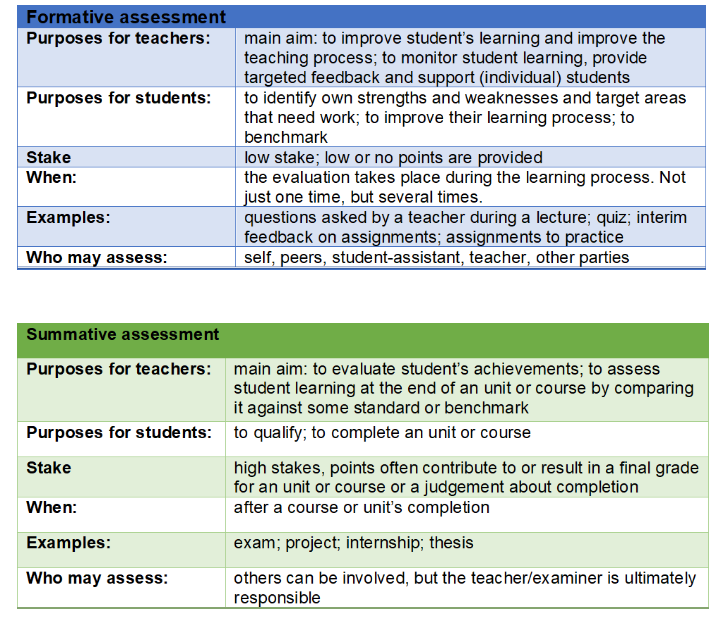
- Choosing a suitable assessment method
How to choose a suitable assessment method?
What to consider when you are looking for a suitable method:
- most important: the alignment with learning objectives and teaching activities; what kind of evidence(s) will prove the achievement of the learning objectives;
- does it comply with the programme's assessment policy and vision;
- purpose (summative and/or formative); if formative: will it be stimulating; is it useful for checking progress or identification of deficiencies; will it support the learning process of the students
- do you assess individuals or groups
- who will be involved in the assessment process; who will assess (self, peers, tutors, teacher, external parties)
- does it suit your experience or do you have ways to learn about the method or get assistance
- practical and efficient, is it do-able (workload for students as well as teachers and others involved)
Advise: If you teach a substantial education unit, use different assessment methods. This way you get a broader picture of the students' capabilities; this will suit different learning styles and capabilities or it can overcome difficulties some students may have with specific assessment methods; this will probably be more motivating for students.
What kind of assessment methods are possible?
There might be a lot of possibilities to suit your learning objectives and course content. The Centre for Teaching Excellence, University of Waterloo, provides a nice overview of all kinds of assessment methods: Types of assignments, and tests.
The Vrije Universiteit offers also a nice overview of assessment methods with the possibility to select based on the amount of students, group vs individual work, and goals and with short descriptions for each option. Assignment and Assessment formats – VU Education Lab Knowledge Base (ctl-vu.nl)
If you like to think a bit out of the box, check out or site on "Alternative Assessment".
Consider also digital tools for formative assessment. The UT has a license for Wooclap, a tool that can be used during lectures to ask questions. On this site you can find information about educational applications that can be used at the UT: About the applications | Overview educational applications | Home EDU systems (utwente.nl).For those who like to get more ideas:
- This is a very nice overview of assessment methods from A-Z. Links to an external site.
- Aligning Outcomes, Assessments, and Instruction | Centre for Teaching Excellence | University of Waterloo (uwaterloo.ca)
- An overview linking assessment methods to Bloom's taxonomy BloomwAssessandTestingJan08Finl (wordpress.com)
- Nice list of formative assessment activities, including explaining what you can do with the data to analyze student’s understanding or progress Selecting and Using Activities and Assessments | Office Of The Associate Vice President For Academic Health Sciences (umn.edu)Links to an external site. / active_learning_activities_and_assessments.pdf (umn.edu)Links to an external site.Links to an external site.
- For formative assessment during lectures and tutorials, you can use questions and answers, or a quiz for instance, but there are a lot of other possibilities. Look [hereLinks to an external site.] for instance for some nice ideas.
- You've learned about Bloom's taxonomy. The University of Waterloo provides an elaborate overview of Bloom's Taxonomy versus learning activities, versus assessment methods. See Bloom's Taxonomy Learning Activities and AssessmentsLinks to an external site.
- An interesting way for students to engage in formative assessment is the IF-AT aka Scratch Cards | Learn TBL method.
- Assessment scheme
How to create an assessment scheme for your course
An assessment scheme (aka test plan, assessment plan) helps to show the validity of your assessment for a course (unit, module).
It provides an overview of all assessments in relation to the learning objectives and with weights and conditions.
At the UT it is expected that the above-mentioned information is presented to the students before the start of a course. As a teacher, you are expected to be able to design an assessment scheme for your course or unit.
You can use different kinds of formats. Below is an example of a format for a course (or education unit within a module) and further below is an example of how an assessment scheme for a module might look like.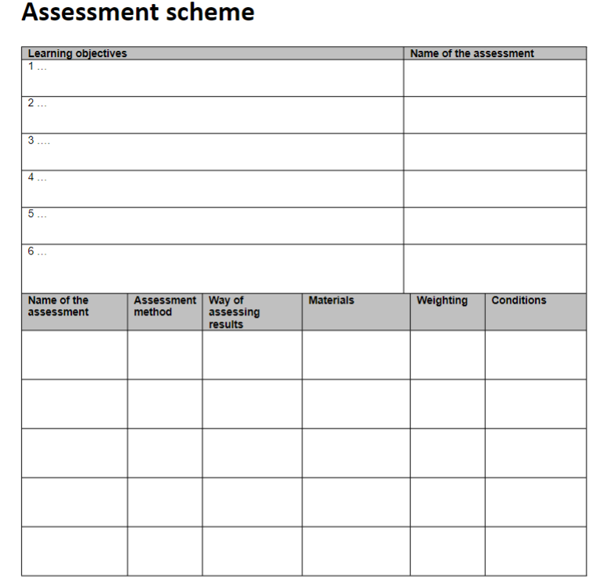
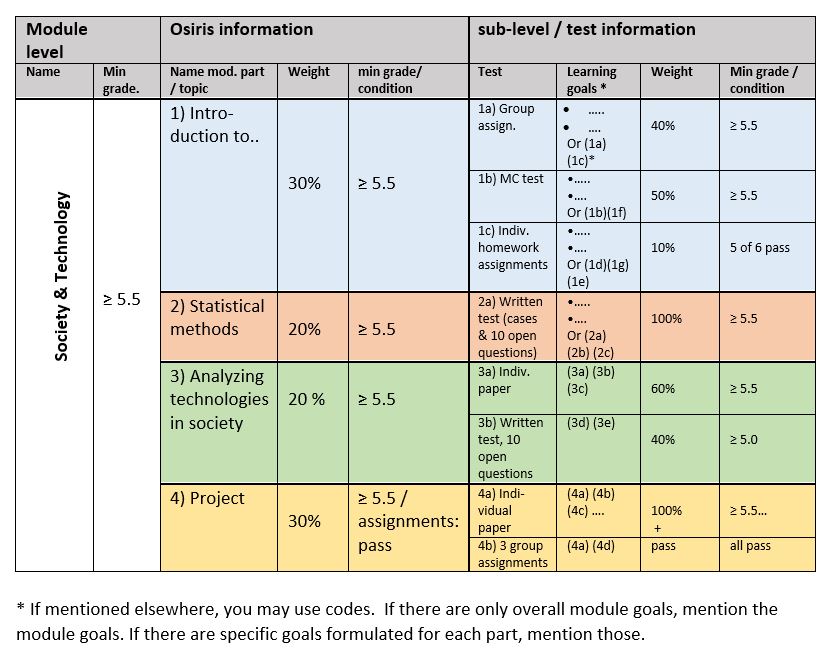
- Assessment specification table
An assessment specification table as a blueprint for your assessment
An assessment specification table for assignments
An assessment specification table is more often created for written tests, but it can also be very useful for assignments, but it will then look a bit different. A specification table for assignments can be very useful to show the alignment between the learning objectives, the activities and deliverables, and the criteria of the course. If you use a rubric, you already have the criteria for a certain output, but this will not show directly the relation with the learning objectives. Now you can check whether all learning objectives are covered. It might turn out that you use more criteria than expected based on the learning objectives or not enough to cover all the objectives. Then you can make adjustments accordingly.>> A useful format can be downloaded [here].
- Student involvement in assessment
Students learn a lot when they are involved in their own learning process (Vermunt & Sluijsmans, 2015). They can also learn a lot when you involve them in the design process of your education including assessments (Bron & Veugelers, 2014).
Some ways to involve students in summative and formative assessment
- Involve students in the choice of assessment method(s)
- Involve students in formulating the assessment criteria for assignments or creating rubrics
- Let students decide which medium they will use to demonstrate what they have learned (e.g. video, podcast, poster, etc.)
- Stimulate students in applying self-assessment. A quiz, checklist, or rubric can be used to guide them.
- Make use of peer assessment or peer feedback. Guidelines and criteria will help to let students focus on the important aspects.
- For a written test: Involve students in creating test questions.
- Discuss homework assignments or e.g. test example questions in class. Start by letting them share and discuss their solutions with peers.
"Students can assess themselves only when they have a sufficiently clear picture of the targets their learning is meant to attain" (Davies, 2011) Besides this quote, a nice model and information can be found on this site: Involve Students - Assessment methods (weebly.com)
